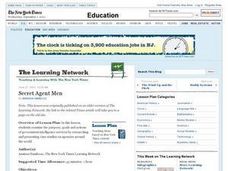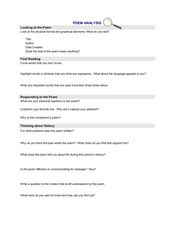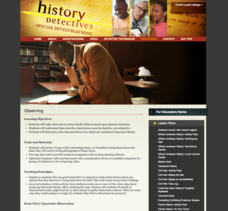Curated OER
Secret Agent Men
What does a secret agent really do? After reading an article, learners discover the connection between intelligence and espionage. Using the Internet, they will research the history and motivations of intelligence agencies throughout the...
Curated OER
Walk in My Shoes
Learners discover how culture, geography and history affect how someone views an area of the world. They role play the role of a Palestinian, Jew or Briton and examine how they felt about Israel during its formation. To end the lesson,...
Curated OER
From Rags to (Paper) Riches: Explore Colonial Papermaking
Young scholars explore Colonial papermaking. In this Colonial America U.S. history lesson, students analyze two poems written in the 1690s about the Rittenhouse paper mill to learn about papermaking. Young scholars produce their own...
Curated OER
Scenario challenge
Fifth graders become familiar with the geography of New Hampshire and the importance of specific sites in history. In this New Hampshire lesson, 5th graders create a brochure including points of interest and showing distances between...
Curated OER
Archeology
Young scholars investigate archaeological discoveries. In this ancient civilizations instructional activity, students research specific archaeological finds and prepare oral presentations to share their findings with their classmates.
Curated OER
Poem Analysis
In this poetry worksheet, students select poems, read them, and then respond to 17 questions about the content, response, and history of the poem.
Curated OER
Make a Comet Model and Eat It!
Young scholars construct a comet model based on procedure provided. In this space science lesson, students compare the physical properties of comets to the models they made. They record their observations and share them with the class.
Curated OER
Thematic Amusement Park Projects
Theme park lesson plans help students learn about history, science, and have fun at the same time.
Curated OER
Antebellum North Carolina
Eighth graders examine pictures & documents relating to the Hayes Plantation (Edenton, NC). They also use various maps of North Carolina to help them analyze how James Cathcart Johnston used, modified and adapted to the physical...
Curated OER
Human Evolution
Students investigate hominid evolution to learn the difference between a relative and an ancestor. They study the emergence of bipedalism and the related physical adaptations and cultural ramifications, and chart patterns of hominid...
Curated OER
HISTORICAL AND SOCIAL SCIENCES ANALYSIS
Young scholars examine a variety of maps and documents to identify physical and cultural features of neighborhoods, cities, states, and countries, to explain the historical migration of people, expansion and disintegration of empires,...
Curated OER
Euthanasia and the T4 Program
Young scholars examine the euthanasia campaign used to rid the world of mentally and physically disabled Germans. Using the internet, they gather information either supporting or disagreeing with the idea of taking a life by euthanasia....
Curated OER
Collecting and Classifying Pollen
Students collect and analyze pollen from different species of plants. In small groups, they classify pollen according to shape, size and physical characteristics. They draw the basic anatomy of flowering plants and create a dichotomous...
Curated OER
Five Utah Indian Tribes
Fourth graders trace the emergence and development of culture in Utah. They study the five Utah Indian Tribes and review several names of physical features of Utah that are derived from Indian words. They discuss how many cultures have...
Curated OER
Art Lesson: Doll Making
Students read and discuss the main characters and supporting characters in the African folktale, "Tiger and the Big Wind." They highlight the physical features of the animal that makes them unique and transfers those same qualities to...
Curated OER
Catapults
Students test catapults. In this physics lesson, student conduct scientific investigations that require them to test catapults. Students practice their problem solving skills as they employ the use of the scientific method.
Curated OER
Principles of Flight: Bernoulli's Lift
Students discover how air pressure effects flight. In this physics lesson, students create two types of airplane wings so they can observe the way air pressure creates lift. Students utilize a printout to create the airplane wings.
Curated OER
Where is the Trail? The Journey of Lewis and Clark
Students explore the trail followed by Lewis and Clark on their journey across the United States. In this United States History lesson, students complete several activities to establish the Lewis and Clark Expedition, including a class...
Curated OER
Amate Bark Paintings/Folk Arts of Latin America
Students explore the history of bark paintings in South America and produce their own version of these paintings.
Curated OER
"Finding" Horsepower
Young scholars investigate horsepower as a unit of power. They examine history and discover that scientists and engineers of high achievement are considered to be among the most valued contributors to their culture.
Curated OER
Sing Away Songs
Students research the history of Bryce Canyon National Park. They identify geological features of the Park while examining its recreational activities. They work together to write lyrics to a song about the Park.
PBS
Observation
Students study making scientific observations . They conduct a "field study" in their attic and make observations about their family artifacts based upon physical attributes. In addition, they determine what characteristics of an object...
Curated OER
Booker T. Washington and W. E. B. DuBois: The Problem of Negro Leadership
Students focus on the problem of African American leadership throughout American history. In groups, they research the life and works of Booker T. Washington and W.E.B. DuBois and how they worked to promote the need for African American...
Curated OER
Every Building Tells a Story
Learners research heritage and culture. They examine architectural images and Charlottetown architecture. They use spatial concepts and models to interpret and make decisions about the organization, distribution, and interaction of...

























